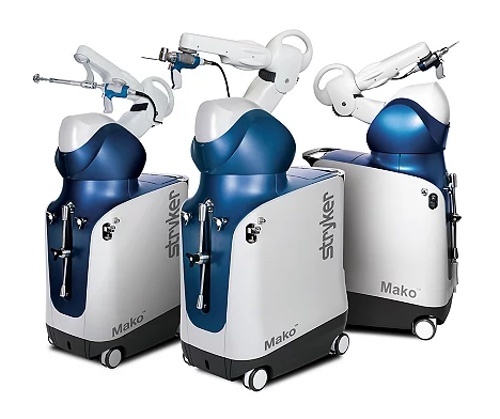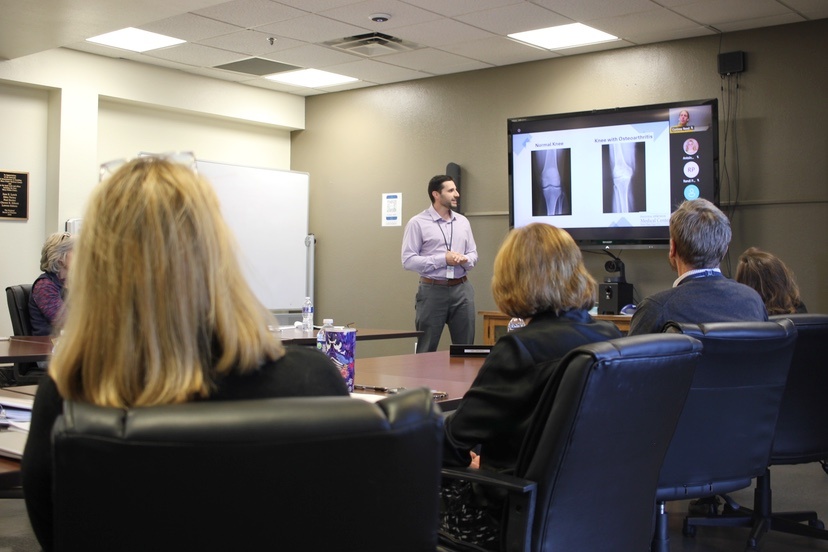The Tuesday, October 22, meeting of the Upper San Juan Health Services District (USJHSD) board of directors kicked off with an educational presentation by one of the new physicians at the Pagosa Springs Medical Center, Dr. Jeremiah Steed. Dr. Steed is now offering a wide range of orthopedic services, including installation of artificial knee and hip replacements.
PSMC already has an orthopedics department under the direction of Dr. Bill Webb. Dr. Webb introduced his new colleague as “beautifully well-trained.”
“He is a very talented surgeon. I’ve operated with him, and he’s the nicest guy in the world. I don’t know how you can beat that. We’re really happy to have him.”
Dr. Webb also assured the board that he is not retiring. Yet. “I’m still enjoying the work.”
Dr. Steed introduced himself and said he grew up in Pagosa Springs and studied medicine at Texas Tech in Lubbock, Texas. “A good place to study, because there’s not a lot else to do. But some of the nicest people you’ll ever meet.” He did his orthopedic residency in Temple, Texas, and then focused on hip and knee surgery in Tacoma, Washington through a one-year Pacific Northwest Hip & Knee Adult Reconstruction Fellowship, offered by MultiCare Orthopedics & Sports Medicine. The fellowship provides fellows with “a thorough and comprehensive approach to the medical and surgical management of patients with orthopedic conditions affecting the hip or the knee.”
According to the MultiCare website, “Fellows are encouraged to participate in research approximately 5 percent of the time with numerous clinical research opportunities available. Conference schedules include a weekly joint replacement/x-ray conference, monthly journal clubs, and educational conferences.”
Dr. Steed then shared a series of comparative x-rays, showing joints with healthy cartilage — the resilient elastic tissue padding that covers and protects the ends of long bones at the joints — compared to joints where the cartilage has disappeared and the joints become painful due to “bone-against-bone” contact. He spent some time discussing several approaches can be taken to minimize pain in these situations, such as reduced activity, use of a cane, use of painkillers, injections, and so on.
He said that re-growing damaged cartilage is a slow process and not often a successful effort.
Ultimately, a patient may choose surgery to replace the joint with an artificial joint — typically made of metal and plastic.
Dr. Steed told the audience that he’d had experience with the Mako robotic arm, a relatively new device that can assist in successful hip and knee replacements. He mentioned that PSMC has budgeted for the purchase of a Mako robotic arm in its 2025 budget.

Online information suggests that a Mako robotic arms were selling for about $1 million each when they were rolled out in 2017. They are sold by Stryker, a multi-national company that also makes prosthetic joints.
Dr. Steed then discussed ‘revision’.
A polite word for ‘replacement, after the artificial joint fails’.
One online article claimed that perhaps 4% of joint implants require revision due to infection, product failure, or poor implantation by the surgeon. Stryker claims its robotic arm technology reduces the need for revision to around 1%.
From a 2018 article by Samuel Greengard on Healthline.com concerning knee replacements:
Revision surgery is more complicated than initial surgery. It’s important to note that a revision knee replacement doesn’t provide the same lifespan as the initial replacement (usually about 10 years rather than 20). The accumulated trauma, scar tissue, and mechanical breakdown of components lead to diminished performance. Revisions are also more susceptible to complications.
If a revision surgery is necessary, you’ll experience specific symptoms. Indications of excessive wear or failure include:
- diminished stability or reduced function in the knee
- increased pain or an infection (which usually occurs soon after the initial procedure)
- a bone fracture or outright device failure
In other cases, bits and pieces of the prosthetic device may break off and cause tiny particles to accumulate around the joint.
A revision procedure is typically more complex than the original knee replacement surgery because the surgeon must remove the original implant, which would have grown into the existing bone. In addition, once the surgeon removes the prosthesis, there is less bone remaining. In some instances, a bone graft — transplanting a piece of bone transplanted from another part of the body or from a donor — might be required to support the new prosthesis.
…The procedure requires additional preoperative planning, specialized tools, and greater surgical skill. The surgery takes longer to perform than a primary initial knee replacement.
“In my training, I did a lot of robotic knee replacements,” Dr. Steed told the audience. “It’s just something I’ve learned a lot about and I’m a big believer, and I really believe it’s kind of the future…
“With Mako, it really can reduce the number of [adjustments] you have to do, because before you even cut bone, interoperatively, I’m able to stress the soft tissue envelope, and I’m able to see what the computer is telling me, and adjust where I make my cuts that ultimately are going to dictate where my implants go…
“I’m still the one who pulls the trigger on the saw, but it’s a tool that allows me to be more precise…”
Later, the USJHSD board approved the 2025 budget — apparently, with money allocated for a Mako robotic arm.

